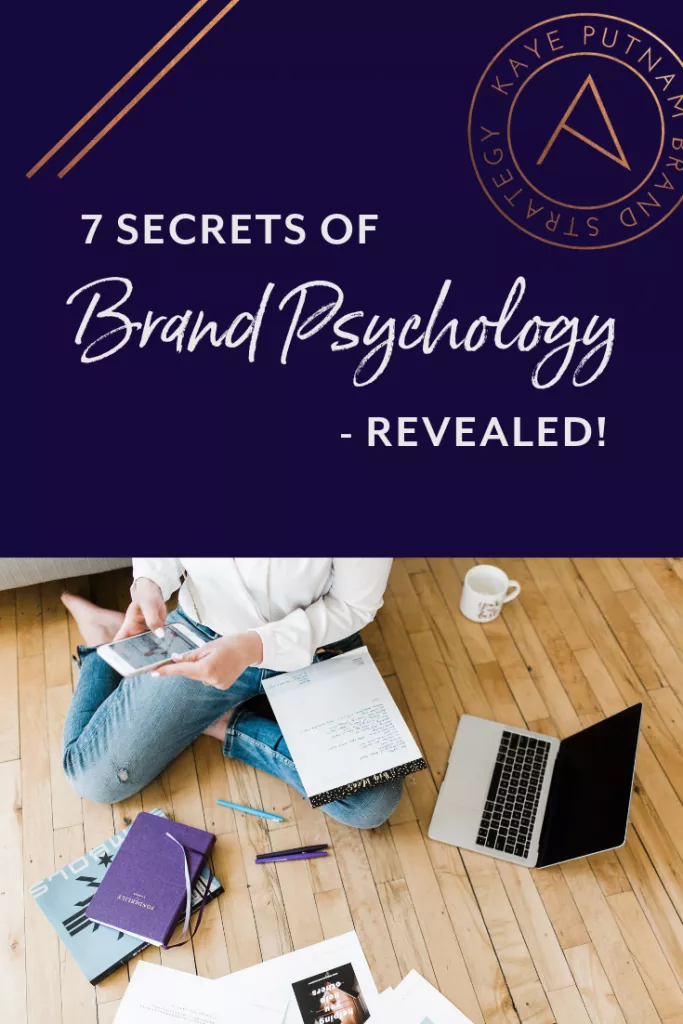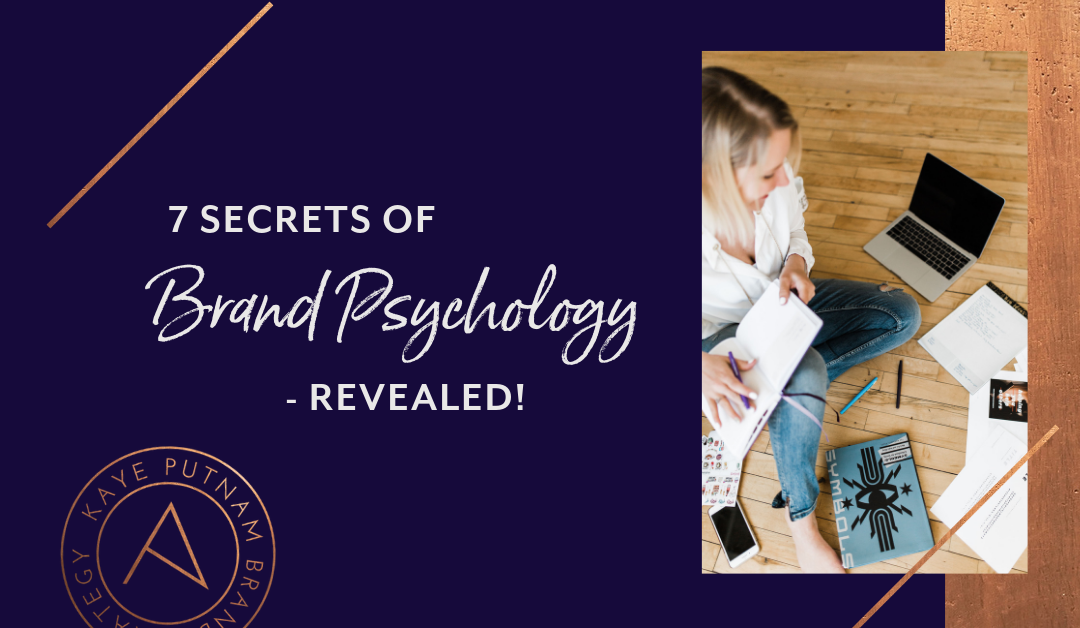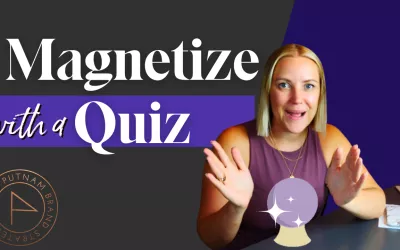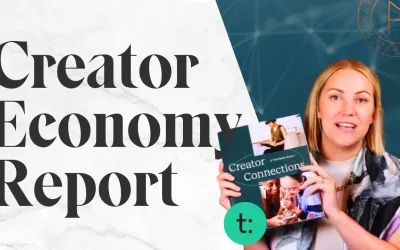Raise your hand if you’re selling to humans!
You are, too? What a coincidence! 🤪
As a brand strategist, I’ve been behind the scenes with hundreds of brands. I’ve worked with big corporations and entrepreneurs. (The small to medium brands like yours are now my jam!) I’ve worked with beginners and business veterans alike. I’ve helped makers… course creators… personal development coaches… Realtors… health providers… (and so many others).
And the common denominator? All of my students and clients sell to humans. (Just like you do!)
(Bear with me. This seemingly obvi statement will pay off below. Pinky-promise!)
So… I noticed early on in my career that some brands are able to cut through all of the noise – and scale and thrive. 🤓 Meanwhile, others fail to gain traction and fizzle out. 😩 It happens every day in business.
But I was obsessed in the beginning with finding out why. And through all my research and hands-on learning, I’ve learned what the difference-maker is…
It’s that one domino that knocks over and causes the momentum needed to make it all work.
It’s both the catalyst and the throughline.
It’s a smart cocktail of “how we think” and how we position our bands.
➡️ It’s brand psychology. ⬅️
Because (Lean in… here’s where I bring this thing full-circle) we’re all looking to appeal to humans, and to hit the right triggers – so the right humans take action on our offers.
And the key to unlocking the secrets of successful brands is actually found in the psychology books. So, in this article, I’m kickin’ it old school and going back to Psych 101. 📚 We’ll re-visit some of the key principles that inform and propel a pyschology-driven brand – and lead to more ideal customers and more sales.
As always, you can watch the video below if you prefer that format. Or, continue on to read this week’s lesson. Your choice, Genius!
What is brand psychology?
Let’s start by laying out a few key definitions for both “branding” and “psychology.” There are so many diverse definitions of both, so let’s come to a common understanding from the get-go, shall we?
(And then, as promised, I’ll reveal those seven brand psychology secrets…)
Defining “a brand.”
The American Marketing Association says that a brand is:
“a name, term, design symbol or any other feature that uniquely identifies one seller’s goods or services from other ones.”
Father of advertising David Ogilvy defined it as:
“an intangible sum of a product’s attributes.”
So, a brand is basically the things that make you, YOU in the market. Plus, it’s the various elements – both tangible and intangible – that symbolize you.
The element that most people think of first in terms of branding is a logo. And, that’s definitely a great example. A catch-phrase, certain fonts, color palates… also good examples.
But, a brand is much more than a logo and colors.
Your brand is characterized and defined by intangibles, too. Your origin story. The themes and opinions you convey. The words you choose…
Even a specific scent – though certainly intangible – can evoke a brand. Think about walking by Abercrombie & Fitch at the mall. That outrageous amount of cologne wafting out into the mall from their store? Gross, yes. But quite recognizable nonetheless – and inextricably linked in our minds to their (stinky 🤣) brand.
Let’s look at one last definition that I find helpful. Businessdictionary.com says:
“Brands help harried consumers in a crowded and complex market place by standing for certain benefits and virtues, or values.”
I like this one because it takes the idea a step further. It acknowledges that brands really only exist when they come into contact with consumers.
My definition is that a brand boils down to this: A brand is intentional alignment over time.
Regardless of which of these definitions resonates more with you, this is true: You’re continually shaping the way that your ideal client perceives you – through all of those different triggers and symbols.
So your brand is shaped by all of the touchpoints with your business, and also by the cultural context that you’re living in. That ongoing work is intentional alignment over time.
Defining “Psychology.”
Now the other half of the equation…
A really simple and useful definition comes from the American Psychology Association. The APA says psychology is:
“the study of how the mind works and how it affects behavior.”
To me, this says it all.
It sums up the importance of psychology in branding. We’ve established previously that we’re selling to humans, right? 😉 And we want our messages to be action-inspiring, right? We want humans (the right ones!) to be compelled by our calls-to-action – to click, do, read, learn, sign up, or buy…
So, we have to know what makes humans act in a specific way. We have to appeal to their human instincts, whether they’re conscious of them or not, right?
Right! And, that’s where we leverage what we know about psychology.
So, now it’s time to dive into the goods – the seven brand psychology principles that will get you racking up the client love in no time flat…
(Oh, one more thing! FYI, this is by no means an exhaustive list… I mean, we’re talking humans here – Complex humans! … but these are some of my favorites. They’re the psych hacks I use when I’m working with my clients one-on-one or in my Brand New Brand program.)
Hack / Secret #1: Humans make decisions emotionally first. Then they back them up with logic.
This first one is critical to understand. Your brand has to meet people at that emotional level – if you want them to buy. (And I know you do!)
Findings from several studies support this, but one of the most seminal was outlined in Harvard professor Gerald Zellman’s 2003 book, The Subconscious Mind of the Consumer. Zellman’s research and learnings prompted him to come to the industry-rocking conclusion that, “95 percent of our purchase decision making takes place in the subconscious mind.” (The book is a fascinating read, and you can get a summary here.)
So here’s what this means for you:
To play into humans’ emotions, you must hit your ideal client at the heart and gut levels – as opposed to just appealing to their brains. This is the tact that will ultimately make them choose you.
To help clients and students do just that, I teach them to intentionally convey a specific personality. (Read more below about brand archetypes.) I also encourage them to leverage images, and to tell stories at many touchpoints (because we know they trigger responses that are as strong as “being there.”)
To dive a whoooooollllle lot deeper into strategies you can use to connect emotionally to ideal clients, check out my article Set Yourself Apart with Emotional Branding.
Okay, so we need to start with emotions. But, then comes “Step 2” of the decision-making process.
Enter our logical sides!
The emotional branding will take us far… but only so far. As marketers, we need to back things up with the rational stuff, too. Though humans tend to make emotional decisions when buying, there comes a moment (generally right before purchase) when we need our logic to pop in and rationally “approve” the decision.
So, be clear on the logical reasons why someone should buy from you. What results have you delivered to others? What ROI or result will this customer experience? Why is your product or service their smartest and best choice?
(You’ll find a classic and highly-effective example of backing things up with logic in the next “secret!” Ready…?)
📌 You can pin this article to reference again later! 📌

Hack / Secret #2: Humans are social creatures.
The second brand psychology tenet to understand is that humans are social. We’re constantly paying attention to the people that influence us. And we’re building our identity within that social construct.
Our base, reptile brain doesn’t ever want us to be cast out from the tribe – lest we be isolated and die. (Dramatic, yes! But we’re hard-wired to function this way. It goes all the way back to our caveman / hunter-gatherer days when it would be dangerous – deadly even! – to be alone.)
So we’re being influenced by everybody around us.
Think about the restaurant that has like a line out the door. That one’s automatically more appealing, even if there’s one right next door is completely open and ready to serve you food. We want the one everyone else wants. Humans are social animals, and our psychology supports that.
So, how do we leverage this knowledge to encourage action and sales? We want to create that “social safety” people crave within our own brands. Do this by showing how many people follow you on social media, by highlighting case studies, or even by interacting publicly with other influential peers. These behaviors and brand assets shows that other people trust us – so this new customer can trust us too.
We can also take a cue from big brands who are leaning more and more into leveraging “user-generated content.” In a classic example, Coca-Cola mounted an international campaign in which those who enjoy the bevvy post photos allllll over the interwebs… We as small business owners can create buzz and community around our brands on a smaller scale using social media engagement, blog comments / conversations, and more.
Oh, and one more BIG one:
We play to the social nature of humans by using testimonials. Remember that “emotional-logical one-two punch” from #1 above? This is why you often see testimonials on sales pages adjacent to the CTA / Buy button, and even on check-out pages… These are apt moments to back things up with tangible, logical proof that the customer is making a good decision!
Hack / Secret #3: Humans want to connect to something bigger.
When we buy, we aren’t just buying a service or product. We’re buying into the bigger ideas that service or product represents.
So, secret #3 is to connect your brand with some universal human values. I love doing this with brand archetypes – those universally recognized characters from history, art, and popular culture who stand for certain basic human motivations and emotions.
Love. Community. Achievement. Individuality… (and many more.) Certain values and feelings are connected to each of the twelve brand archetypes I use with my clients as we’re defining their brand’s messages, stories, and aesthetics.
Archetypes give us a proven mechanism by which to convey our messages at that “heart and gut level.” We don’t want to simply tout our products’ features or benefits. We need to connect what we sell to ideal buyers’ values – if we want people to truly pay attention and value us.
(Pssssst… If you’ve been around these parts for a bit, you recognize the archetypes. But if you’re like, “Huh?????”… and you’re intrigued 🤓, take my popular brand personality quiz. It takes about ten minutes – and it will reveal *your* brand archetypes! The quiz has now been taken more than 110,000 times now!)
Hack / Secret #4: Humans have short attention spans.
Before we can actually say anything (and be heard), we first must actually get people to pay attention… to notice us. Then, we need to keep their attention long enough to convey our message.
For better or for worse, our attention spans are ridiculously short at this juncture of civilization. (Likely some sort of evolutionary defense mechanism against information overload ammiright?)
In fact, a 2015 study by Microsoft Corp proved that humans generally lose their ability to concentrate on something after 8 seconds. 😲😲😲 The New York Times added in the article linked above that the “notoriously ill-focused goldfish” has an attention span of 9 seconds, so…..Umm, Yeah. 😳😳😳 It’s really hard to get – and keep – people’s attention.
So, what’s an entrepreneur to do? (“Ugh! I’m marketing to a goldfish!” 😉)
Here’s the key: You must make it super-apparent that what you have to say is hyper-relevant to your audience.
Imagine you’re at a cocktail party, and you hear your name. It doesn’t matter if somebody’s talking to you… If you hear your name, your ears perk up, right?
Demonstrating relevance to grab attention is just like that. If you can show your ideal client that you understand her… that you’re talking about her specifically in your brand? That’s going to get her to take notice – even in a noisy market.
Your messages (especially your hooks and introductions) should almost feel eery… like you’re joining a conversation your ideal client is already having in her head. (This is why understanding your ideal client’s desires, motivations, problems, and pain points is so critical.)
Hack / Secret #5: Human brains are always looking for patterns.
Our brains are always working to make connections. They’re always looking for patterns to understand the world around us. Again, the reason can be found in understanding our ancestors.
In his book How We Believe, Michael Shermer discusses that recognizing patterns (like tides, movement of the sun, farming seasons, and even reproductive cycles) has made it possible for our species to survive and thrive. “Pattern recognition,” he says, has been “imperative to learning.” It’s how our ancestors ensured they could be safe, have full bellies, and even propagate the species!
Our craving for order makes more sense now, right? (Except you, Mavericks! I know you’re waaaaaay over order. 😉)
As a marketer, you can use this information to give ‘em what they want…
You can create shortcuts to understanding. By aligning your messages with patterns that already exist, you can convey what your deeper message is (and this is the key!) ➡️ in a very quick way. ⬅️ (… Glub glub. 😉 🐠)
Again, this is where brand archetypes come in. Leveraging them takes advantage of those existing patterns our brains recognize… associations that we already make – naturally. Based on what fonts a brand uses, what images it uses – and more – humans encounter archetypes and know what they stand for.
Hack / Secret #6: Familiarity = Appeal.
Psychological number six is a weird one. (At least I think so!)
The “Mere-Exposure” Effect (coined by Robert Zajonc in 1968, and cited by #alltheMarketingProfs – to this day!) is the tenet that says “repeated exposure of the individual to a stimulus object enhances his attitude toward it.”
In plainer terms, the more that we see something (a person’s face, a piece of art, a logo, anything!), the more that we like it.
Back in the day, Zajonc showed images to study participants and asked them to rate them based on how much they “liked” them. Some people were asked to rate pictures after having seen them only once. Some were shown them multiple times, then asked to rate them. The participants who rated the images after 20+ views gave the said images much higher marks – across the board.
There’s that reptile brain again… still controlling our responses generations later… This time it’s trying to keep us safe, right? Anything that’s new or novel is exciting, but it may be dangerous, too. (Eeek! Stranger, danger! We instinctively think: “Careful, this person might be trying to harm me or trick me.”)
So, if we see somebody a lot, we begin to like them a lot. And you can play into this simply by just consistently showing up. I mean, even if you’re not doing anything else right… If you’re just showing up and being visible where your ideal clients are, that consistency will build trust over time and bond them to you. (It’s science!)
Hack / Secret #7: Our brains seek “hits” of novelty and excitement.
This final brand psychology secret is about understanding the “reward system” in the human brain.
The reward system is a scientific term (Nope! I didn’t just make it up! 🤣) that refers to a group of structures in the brain that are activated by rewarding or reinforcing things we encounter (like a delicious smell, a touch that feels great, or – sadly – addictive drugs.)
When exposed to a rewarding stimulus, the brain releases hits of dopamine (our neuro-transmitting chemical – not the manufactured drug).
Basically, our brains have developed “feel good” circuits – and we look to trigger ‘em at every turn. (Chocolate cake! A hug! Getting a compliment! We eat it up!)
Yep, by nature, we’re constantly looking for hits of this natural dopamine. So, if you can create content that is entertaining, novel, exciting somehow – or just fun! – you’ll give people that hit…. You’re going to be lighting up those pleasure systems and they’ll want to keep coming back again and again to your brand.
So, there you have them… Seven of my favorite brand psychology principles – all based on science and all for YOU to leverage! Incorporate one, incorporate them all… but understand that psychology is a collection of human truths. These truths aren’t changing anytime soon, and they impact the success (or failure) of your brand. So, it makes sense to pay attention to how human brains work… ‘Cause we’re all selling to humans, right? 🤣
One last thing: If you found this article helpful, and you’re craving crystal clarity around your brand (and *exactly* how you can show up and stand out)… I have something special – and FREE – for you!
You can enroll now in my Define Your Brand Masterclass. In one value-packed training, you’ll get crystal clear on your brand – and walk away with a 1-page brand plan.
It’s totally free for you, Dear Reader! So, don’t sit around in a fog of uncertainty ☁️☁️☁️… Sign up and learn here. 💡 See you in the training!





Hi Kaye!
Love your articles and how insightful they are. I’d love to see some examples with the prompts you mention here, sometimes it gets a little difficult to understand. Like, here I’m not very clear of what the patterns point means.